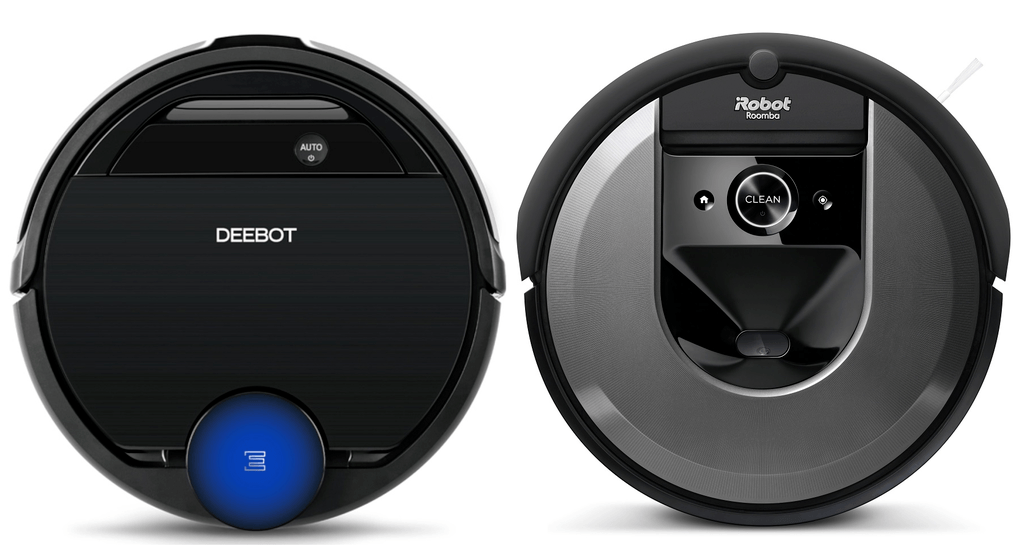With Roomba doing everything in their power to stay on top of the market, newcomers and old rivals keep pushing the envelope. With the Roomba i7+ we were introduced to a self-emptying robot. Now Ecovacs introduces technology to avoid obstacles in real time.
How does the Ecovacs Deebot OZMO 960 compare to the similarly priced Roomba i7+? This article will review and compare the two robots on all the features that matter. Interested to find out who wins? If you are in a hurry, the pick goes to the Roomba i7+. Read on to find out why.
Contents
- 1 The Differences
- 2 The Similarities
- 3 Specifications Chart
- 4 Comparing the Ecovaces Deebot OZMO 960 Vs. Roomba i7+
- 5 Frequently Asked Questions
- 5.1 Q. Do you have to get the Roomba i7+ to have a self-emptying robot?
- 5.2 Q. Where can I get the best price on the Roomba i7+ or the Deebot 960?
- 5.3 Q. Which robot vacuum closely matches the Ecovacs Deebot OZMO 960 in performance and abilities?
- 5.4 Q. If the robots can run for a couple of hours, what is the square footage they can cover?
- 5.5 Q. Can the robot vacuums clean stairs?
- 6 What I Like About the Deebot 960
- 7 What I Like About the Roomba i7+
- 8 Conclusion
The Differences
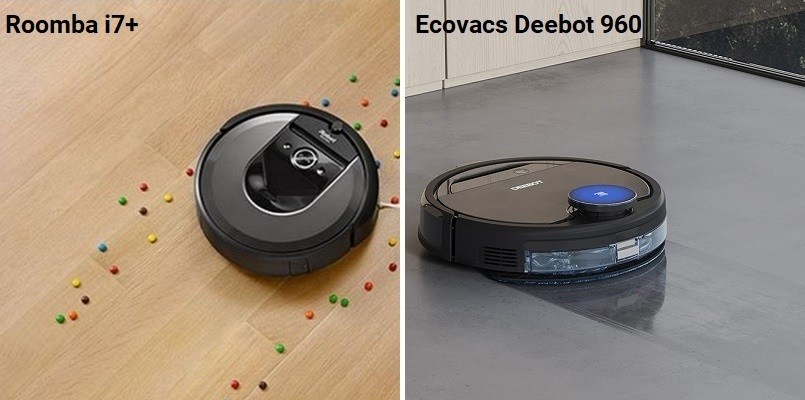
There are quite a few differences in the two models compared here today. Let’s see what those differences are.
- The Deebot 960 can mop and vacuum. The Roomba i7+ only vacuums.
- Camera assist. Roomba doesn’t use a camera to see as it moves. The Ecovacs robot has a camera designed to spot new obstacles as it is cleaning.
- Imprint Technology. The i7+ has a new technology that allows it to communicate with the Braava M6 and gives interactivity to the created map. Deebot doesn’t offer this.
- Washable collection bin. The Roomba i7+ has a washable bin that the Deebot doesn’t have.
- Navigation systems. Ecovacs Deebot 960 uses laser guided navigation (LIDAR) while the Roomba i7+ uses camera-based navigation (iAdapt 3.0).
- Extraction methods. Deebot 960 uses a single, optional brush roller with two side brushes for sweeping and vacuuming. The Roomba model has a single side brush and two brushless rubber extractors for cleaning.
The Similarities
All other aspects of the two robots will be the same or close to the same. Here is a list of the more important specifications that they share in common.
- Recharge and Resume. Both robots will monitor their own batteries, charging and returning to finish the cleaning job as needed.
- Floor types cleaned. The two models are rated to clean all floor types including carpet, laminate, tile, vinyl and more.
- The Ecovacs Deebot 960 and the Roomba i7+ both use HEPA quality filters.
- Wireless controls. Each of the models listed here will use wireless controls to allow the use of mobile app and voice commands.
- Digital containment. The Deebot 960 and Roomba i7+ have interactive maps that allow you to create digital containment areas.
Specifications Chart
Let’s take a look at the rest of the features and options that the two robots offer you (or don’t offer you)
| Roomba i7+ | Ecovacs Deebot OZMO 960 | |
| Size | 13.34×13.34×3.63 | 13.9×13.9×4.0 inches |
| Weight | 7.44 pounds | 6.6 pounds |
| Navigation | iAdapt 3.0 | Smart Navi 3.0 with AIVI(TM) |
| Battery | 3300mAh Lithium-Ion | 3200mAH Lithium-ion |
| Runtime | Up to 120 minutes | Up to 110 minutes |
| Charge Time | 3 hours | About 3 hours |
| Automatic Recharge | Yes | Yes |
| Entire Level Clean | Yes | Yes |
| Filter | High-efficiency | HEPA |
| Carpet Boost | Yes | Yes |
| Drop Sensors | Yes | Yes |
| Bump Sensors | Yes | Yes |
| Dirt Detection Sensors | Yes | No |
| Camera Navigation | Yes | No |
| Laser Navigation | No | Yes |
| Camera Assist | No | Yes |
| Mopping | No | Yes |
| Water Reservoir Capacity | N/A | 250ml |
| Wireless Communications | Yes | Yes |
| Mobile App | Yes | Yes |
| Voice Controls | Yes | Yes |
| Floor Types | All | All |
| Imprint Smart Mapping | Yes | No |
| Imprint Link | Yes | No |
| Room Select Cleaning | Yes | Yes |
| Keep Out Zones | Yes | Yes |
| Collection Bin Capacity | 0.6L | 0.47L |
| Washable Collection Bin | Yes | No |
| Automatic Collection Bin Emptying | Yes | No |
| Side Brushes | 1 Side Brush | 2 Side Brushes |
| Containment | Dual-Mode Virtual Wall Barrier | Digital Containment (app only) |
| Warranty | 1 Year | 1 year |
| Price | Check on Amazon | Check on Amazon |
Comparing the Ecovaces Deebot OZMO 960 Vs. Roomba i7+
Now I will take those features listed above and compare the Roomba and Ecovacs robots against each other. By the end of this section, you should have a better understanding of how the robots work and which one is better suited for your home.
The Robot Basics
All robot cleaners have specific things that they cannot work without. Things such as the batteries, extractors and collection bins. I refer to these as the “basics” and while all robots have them, they come in various shapes, sizes and capabilities.
The batteries in these two models are pretty much the same. Both give you about two hours of runtime and take about three hours to recharge. The robots also monitor their own batteries, which means that when the charge drops below 10-15%, both models return to the charging dock to refill.
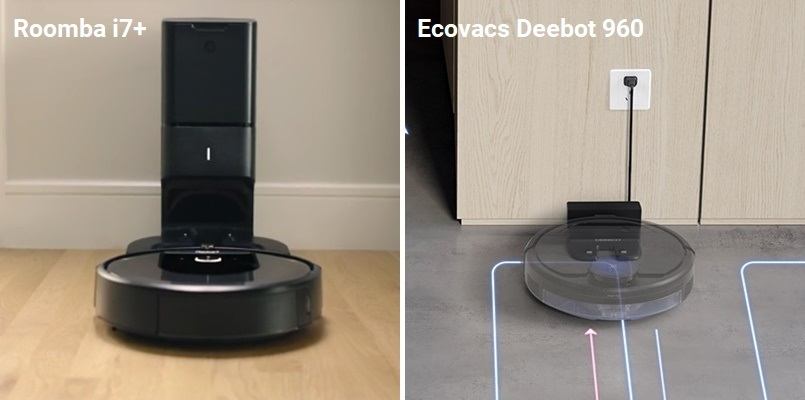
With a feature known as Recharge & Resume, the robots also know how much cleaning is left to complete for the scheduled session. Once the recharge is complete, the i7+ and the 960 will resume cleaning where they left off until the job is done.
Extraction and Collection
The two models also have similar collection bin sizes, a variance of 0.13L, which sees the Roomba with the larger bin. However, it is the method of collection that is different and the edge definitely goes to the Roomba robot.
Roomba uses two rubber extractors. They don’t have bristles and instead use rubber paddles to agitate carpet, loosen and lift debris and pull it into the collection bin. The paddles rotate opposite each other and work to keep the debris small enough for collection without clogging.
Since there aren’t any bristles, there is less chance of hair, string or pet fur getting tangled around them. When it happens, all you have to do is remove the rollers, wipe them off with your hand or a paper towel, and put them back in the robot. The entire process takes less than a minute.
Last, these rollers are “tangle-free.” This means that the robot notices when it picks up something it shouldn’t, like a power cord or a sock. When this happens, the robot will stop forward motion and reverse the rollers in an attempt to dislodge the sock. If successful, it will move around the object and continue cleaning. If it fails, the robot shuts down to prevent damage.
The Ecovacs model is more traditional. It uses a single bristled roller for agitation and collection. The brush roller does a decent job for what it is, but cleaning can be a nightmare. Pet hair, strings and carpet fibers easily wrap and get caught up in the bristles. There is a brush cleaning tool included that you can use to assist the removal of the entangling.
You also have the option not to use the roller at all. You can remove it from the robot and it will rely on the side brushes and pure suction power to lift the debris for collection.
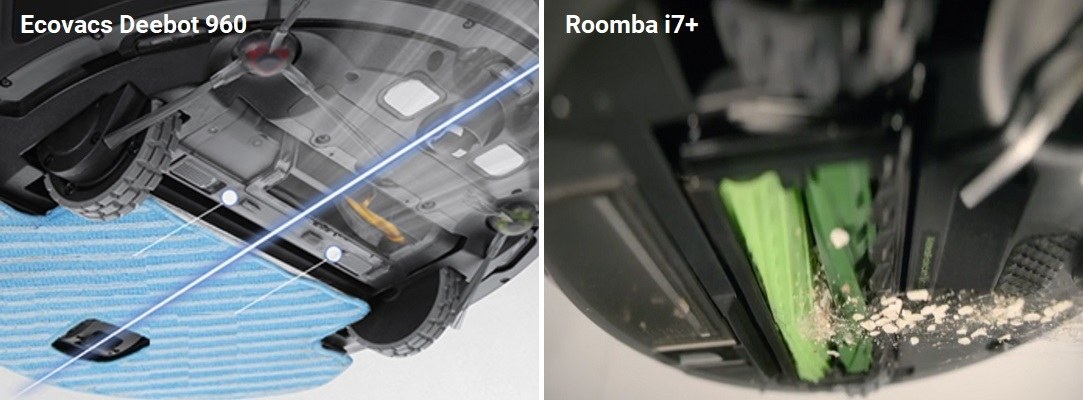
Bottom Line: The Roomba i7+ has the advantage in the robot basics. The extraction method is much better than the Deebot 960. Couple that with a larger collection bin and better battery performance, however slight, and it’s a slam dunk.
Roomba and Deebot use different navigation and mapping systems. Neither is technically better than the other, but it is important to note how the two systems operate.
The Ecovacs Deebot 960 uses LIDAR, also called LDS. This is a laser-based system that scans the ceiling as the robot moves around the home. The laser looks for corners, doorways, windows and landmarks like lights and ceiling fans. From these scans, the robot can build a fairly accurate floor plan of your home.
Using the drop and bump sensors, the map crated is completed by noting where walls, large furniture and other immovable obstacles are located.
The Roomba i7+ on the other hand, uses a camera-based navigation and mapping system called iAdapt 3.0. As the robot moves around the home, a camera takes thousands of low-resolution photos. iAdapt 3.0 algorithms put the pictures together to create a rudimentary 3-D image of your house. From there, it is transformed into a 2-D, top-down view map that is uploaded to the mobile app.
Like the Deebot, the Roomba also uses the drop and bump sensors to locate obstacles and note places where it cannot access and updates the map.
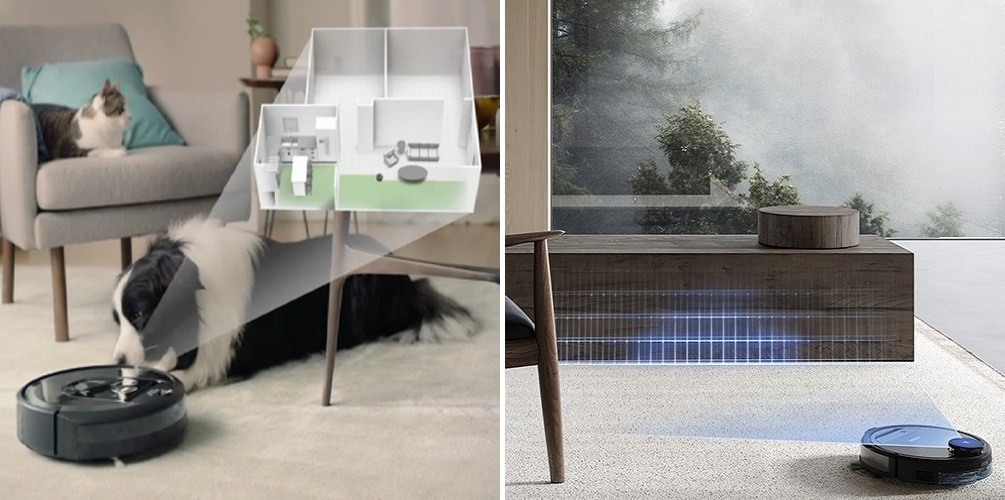
Bottom Line: This is a tie. The systems work to allow the robots to maneuver the home and create interactive maps for the mobile app.
Containment and Filters
Filtration is a common worry for a lot of households across the nation. Our floors and carpets can become covered in allergy-inducing particles like pet dander, pollen, mold spores and dust mites.
HEPA filtration cuts down on the amount of in-home allergens by as much as 99%. There should be a HEPA filter in your HVAC system, another in your standard upright vacuum and now, in your robot. HEPA filtration in robots is not new, but it isn’t as common as you think. Both of these models use HEPA quality filtration, capturing up to 99% of those allergens when they clean.
Telling the robots where to clean has always been a bit of a chore. Some robots don’t have any containment at all, others use strips of magnetic tape. The Roomba i7+ has several forms of containment. There is the physical containment from the dual-mode virtual wall barriers , for example. You also have the option of using digital containment through the mobile app (and your voice controls!)
On the mobile app, you can name and label rooms. From there you can program the robot to clean a specific room, all rooms or avoid certain areas. You can even use voice commands to have the robot clean a single room at any time.
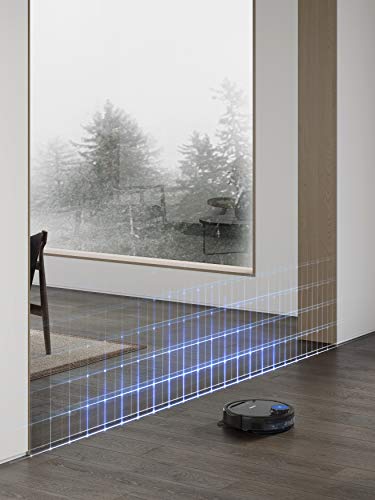
The Deebot OZMO 960 doesn’t use physical containment options. However, it has digital containment. Similar to Neato D-Series robots, you can use the mobile app to create no-go lines. Drawing lines and squares on the map where you do not want the robot to go has always been tricky. Neato still doesn’t have it quite right and Ecovacs is far behind their capabilities. (more on that below).
There is also the option to draw areas where you only want the robot to clean specifically. These areas are more like a digital spot clean. And, like the Roomba i7+, the Deebot 960 will avoid entire rooms you mark as off-limits.
Bottom Line: The Roomba i7+ wins this round with more containment options. The digital options work better, as well, which helps solidify the win.
Mobile App
When you compare the mobile apps on their specs and abilities, they appear quite similar. They have the same characteristics, functions and ease-of-use. However, there is one glaring difference that makes the comparison battle an easy win. The iRobot Home app for Roomba works.
With the Roomba app, you get all of the cleaning modes, scheduling, programming and status features you would expect. You also get the interactive map to name rooms, create digital containment lines and areas. You can find out how long the robot ran, the battery usage, when it stopped to recharge and even when it is time to change the filter.
Thanks to Imprint Technology, you can even pair the i7+ to the Braava M6 mopping robot and the two will run on the same schedules and keep your floors clean without you having to lift more than a finger. The Imprint Smart Mapping is what gives you the interactive controls, and it also allows the robot to store up to 10 different floor plans.
The Deebot 960 Mobile App is Lacking
While everything is similar on paper, the Deebot app is more of a headache. This is mainly because of the connectivity issues. It may take you 5 or 6 attempts to get the app to link to the robot. Add to that frustration with the map interactivity not working so well. You may have to tap the screen over a dozen times before it registers, draws a line and lets you resize it.
Moreover, the app will randomly stop working. This requires that you uninstall the app, reinstall it and start the process all over again. Frustration is an understatement, but I refrain from saying more as kids may be reading this.
When the app works, it does what it says it will do. The robot won’t adhere to the exact lines you draw, but it will be close enough. You just have to get it to work first.
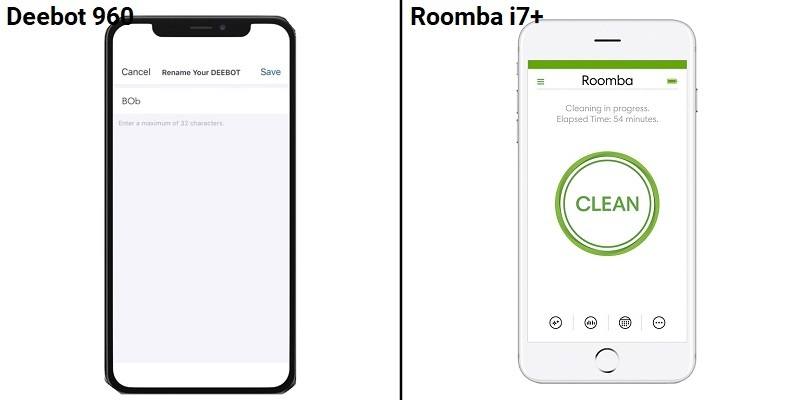
Bottom Line: Roomba wins easily. Their app works, and since the mid-600 series, iRobot has had the best robot mobile app available.
The Unique Traits (Mopping vs. Self-Empty)
Both of these robots bring something unique to the table. In any other comparison, I would include the digital containment options here, but since the i7+ and 960 both offer them, they remain on the sideline.
The unique feature of the Roomba i7+ is that it is the first robot to self-empty the collection bin. The Roomba s9+ also does this, but the i7+ was the first. Instead of the Home Base charging station, the i7+ comes with a Clean Base dock and a special collection bin.
The collection bin holds about 0.6L of debris and has a rubber stopper covering a hole in the bottom. When the robot docks, the motor inside the Clean Base turns on, it pulls the rubber stopper aside and extracts the debris from the collection bin.
Inside the Clean Base is a vacuum bag. It also self-seals when you remove it, preventing anything from getting out. The bag will hold about 30 bins worth of debris before it needs to be changed. So, ideally, you can run the robot once a day for a month without having to worry about emptying the collection bin.
When the time comes, you open the top of the Clean Base, pull the handle and toss the bag in the garbage. A replacement bag is needed, and this is cause for concern for a lot of owners. For those looking to cut down on consumption and a waste of paper and plastic, you may be turned off by this feature.
Ecovacs Give the Deebot 960 an OZMO Water Tank
Deebot’s unique feature is the ability for it to mop. Using an Ozmo water reservoir mopping system, you can fill the tank with water, attach the mopping pad and away it goes. What’s better than most 3-in-1 robots, is that the Deebot 960 can sweep and mop at the same time.
If you remove the brush roller, the robot will sweep the hard flooring ahead of the mopping pad. As the tank releases water to the pad, the pad will mop the hard flooring surface directly after it is cleaned by the vacuum.
Unfortunately, there isn’t a scrubbing action and the mop, like most mopping robots, is lack-luster. It works better than some robots, but the result is still a wet cloth dragged across your floor. Most users find the mopping feature nothing more than a novelty, and I tend to agree.
If you want a robot to mop your floors and do a job good enough to write about, it needs to be a dedicated mopping robot. One of the best right now is the Braava 280t because it scrubs while cleaning.
The Deebot 960 Also Has a Camera-Based Feature
One other unique thing the Deebot offers is a camera to see where it is going. If you are tossing your socks around the floor, the robot is supposed to see them and avoid them completely. Of course, the marketing department is too scared to say what we all want them to say. The robot is designed to avoid running over poop.
There. I said it. The camera spots new obstacles and measures their size. If it is deemed to be a “sock” or something similar, the robot goes around it. However, this technology doesn’t always work. You will see that the robot doesn’t look like it has any navigation at all sometimes.
It will run into furniture, pet dishes and even its own charging station. Forget that sock. You’re still coming home to have to clean up a smeared “sock” stain more often than not.
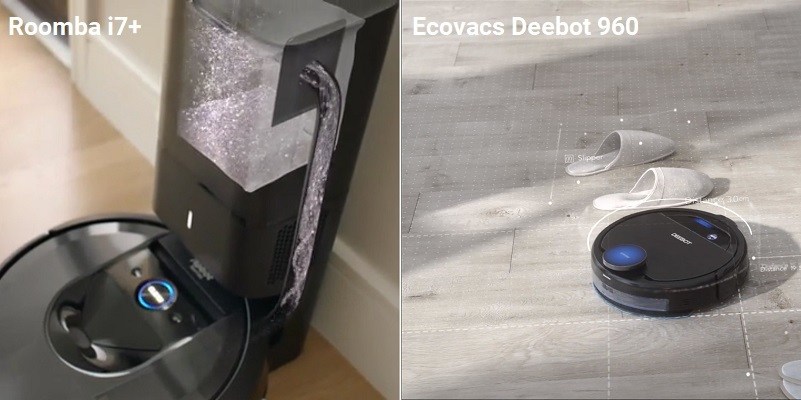
Bottom Line: Since these are unique features, there isn’t a winner. However, the self-emptying i7+ works and does what it says it does, while the mopping 960 is more hit or miss and may not be an often used feature. Let’s not talk about the poop avoidance again, okay?
Real-World Testing
I will assume that you don’t live in a lab testing environment. Based on that assumption, I won’t test these robots in a lab setting with strict controls on how much salt and cereal get evenly placed on a specific spot on the floor. These real-world tests give you the scoop on how the robots will perform in your home, during your daily lives.
On Carpeting
When you put the Deebot 960 on your carpet, it will clean them. Most of them anyway. Low pile is preferred, but it will do an okay job on medium piled carpet, too. If you have high-pile, shag or even medium pile with loose-woven fibers, though, you’re out of luck.
The brush roller will get easily tangled in carpet fibers, rug fringe and lighter throws. For these types of carpeting, you can remove the roller, but the straight suction power isn’t enough to get deep into the carpet fibers.
The Roomba i7+ will also clean low and medium-pile carpeting. Thanks to the rubber extractors, it will also handle high-pile carpet well. Rug fringe and shag carpeting can be a challenge, but it tries.
The i7+ also has carpet boost that allows it to increase motor and suction speed to get an even deeper clean. You will notice the difference between the two models on your carpeting, with the i7+ having a more thorough, deeper clean.
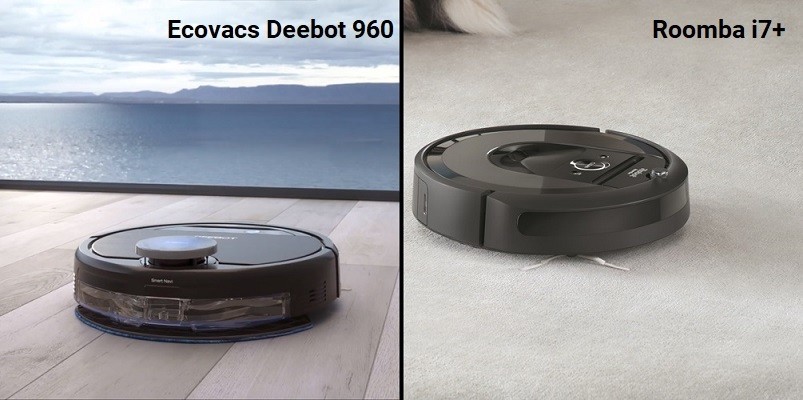
On Hard Flooring
The cleaned areas of your hard flooring are about the same with both robots. The Deebot starts with the advantage because of the removable roller which helps when you are mopping while vacuuming.
Both models do well along the edges, though the i7+ has a better time getting into corners, even though it only has a single side brush. The i7+ still pushes lighter debris around for a while before picking it up; a known problem for Roomba.
Because of the speed of the side brush and the exhaust venting, which is corrected in the s9 models, the lighter dust and debris get blown around before being collected.
The Deebot doesn’t have this problem as much, but it has a bigger one. The navigation is sound and the maps are complete, but the Deebot 960 still misses a lot of areas. You will notice a completed scheduled clean on your mobile app. However, if you look at the cleaning map report, you will see all the areas the robot missed.
To be honest, I haven’t seen a top-tier robot miss this much cleaning area in a run since the Roomba 650, maybe not even then.
Dealing With Pet Hair
When it comes to pet hair, it isn’t a contest. The Roomba i7+ and the rubber extractors get virtually everything. While you will need to clean off the rollers afterward, it takes seconds to do and there isn’t much there, to be honest. Along the edges where most of the pet hair ends up, the Roomba will scurry along, picking up everything with the side brush.
The Deebot 960 will also clean up pet hair, and along edges it will get most of it. You will notice tufts left behind and there will still be some embedded in your carpets. The small brush roller isn’t as adept at picking up hair and string like the i7+ does, but it is a marked improvement over doing nothing, I suppose.
The maintenance of the brush roller is the real downfall. It takes ages to get everything off. The saving grace is that you don’t have to disassemble the while thing to get to the brush roller. The handy cleaning tool is right there, too, tucked away, so it doesn’t get lost.
Frequently Asked Questions
Now let’s cover some of the common questions that come up about these two robots. If you have further questions, please feel free to ask them in the comment section below.
Q. Do you have to get the Roomba i7+ to have a self-emptying robot?
A. If you want a robot that empties itself, you currently have three options. The Roomba i7+ and s9+ hold the patent on the self-emptying abilities. However, the Shark IQ Auto-Empty does it as well (at least until the court battle over the patent is over). If you like the I7= but don’t want to pay for the self-cleaning, you can downgrade to the Roomba i7. The only difference is that the i7 doesn’t have the self-emptying capabilities.
Q. Where can I get the best price on the Roomba i7+ or the Deebot 960?
A. The best prices are going to be found through Amazon at the moment. iRobot’s shop front there will have sales and specials that aren’t always available on their website. For the Deebot, you won’t see a lot of price difference at the moment, but it does qualify for Amazon Prime member perks.
Q. Which robot vacuum closely matches the Ecovacs Deebot OZMO 960 in performance and abilities?
A. When it comes to abilities, the best alternative is going to be another 3-in-1 robot that can mop and cleans well. The bObSweep Pet Hair Plus is the best option. It doesn’t have wireless controls, but it does have a remote and an integrated full-function 3.5-inch LCD. When it comes to price and expectations, the Roomba i7+ is the closest, though, as you have read in this review, the Roomba is a far superior cleaning robot.
Q. If the robots can run for a couple of hours, what is the square footage they can cover?
A. For the most part, runtime is averaged in minutes and by minutes per room. The Roomba makes efficient use of the battery and can clean a single room in about 21 minutes. The total square footage will vary based on he floor types it cleans. More carpets mean more carpet boost and a shorter battery life. On average yo ucan expect to clean between 1400 and 1800 square feet on a single charge. For the Deebot 960, it averages about 25 minutes per room, which cuts the overall coverage down to between 1150 and 1300 square feet per charge.
Q. Can the robot vacuums clean stairs?
A. If you move the robots along the stair and then lift and repeat for each stair, it is technically possible. However, no robot vacuum has been released that can climb stairs to clean them. There are efforts to make this a reality and some companies have come close. Nothing is marketable at the moment, though.
What I Like About the Deebot 960
- Carpet detection prevents the robot from mopping rugs and carpeted rooms.
- One of a few robots that vacuums while it mops.
- Digital containment (when it works) beats physical containment.
What I Like About the Roomba i7+
- Efficient battery use.
- Self-emptying robot that goes 30 days without needing assistance.
- Entire maintenance routine takes less than 5 minutes.
Conclusion
I compared and reviewed the Ecovacs Deebot OZMO 960 vs. the Roomba i7+ because of their similar price points and abilities on paper. However, as you can see from the reviews and real-world testing outcomes, the Deebot doesn’t come close.
If you want to spend over $1000 on a robot vacuum, there is nothing stopping you. However, you should expect more from your robot than an app that may never work, continually missed cleaning areas and the only form of containment being sporadic at best.
For the money, effort and time needed on these top-tier robots, the Roomba i7+ is the easy winner. If you want a more suitable comparison between robots with abilities, I have also compared the Deebot 960 to the Roomba 960 for you here .
